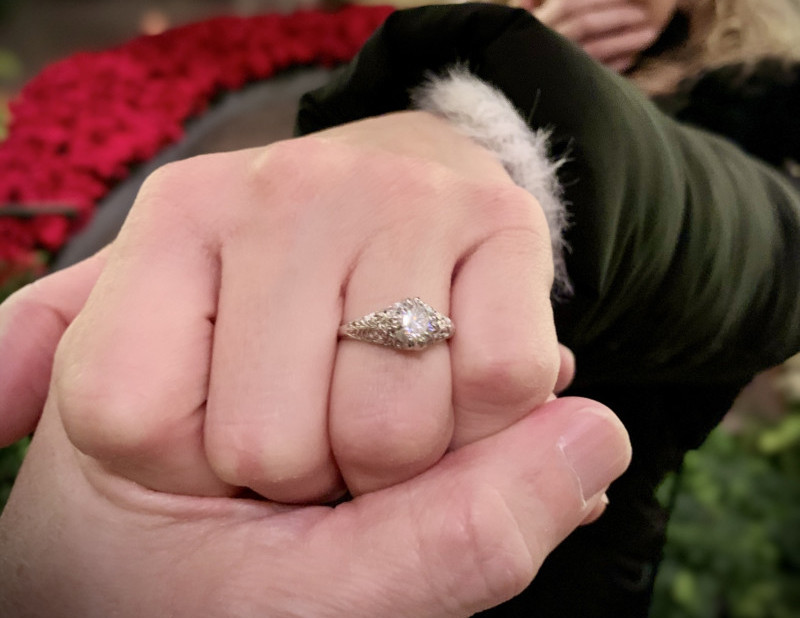 Diamonds are forever: this is why couples choose diamonds on their engagement rings as a symbol of their strong and binding eternal love and devotion to each other. That, and that they are also extremely pretty, which is attributed to the strange nature of most living things, being attracted to anything even remotely shiny or sparkly (not just humans, but also birds, hyperactive cats, and a myriad of underwater sea creatures too).
Diamonds are forever: this is why couples choose diamonds on their engagement rings as a symbol of their strong and binding eternal love and devotion to each other. That, and that they are also extremely pretty, which is attributed to the strange nature of most living things, being attracted to anything even remotely shiny or sparkly (not just humans, but also birds, hyperactive cats, and a myriad of underwater sea creatures too).
However, diamonds as the lone and ultimate choice in putting pretty rocks on fingers of wives-to-be are not coming off as practical things; people will still keep wanting to get married, and they are still going to keep insisting on engagement and the accessories that come thereof. But one mustn’t give up on the notions of romance!
Diamond Replacements
Cubic Zirconia, the cubic, crystalline form of zirconium dioxide and its synthetic form, has remained the most geologically and economically important competitor of the diamond due to its low cost, durability, and almost spot-on visual likeness of an actual diamond.
 Moissanite, another diamond dead-ringer, is originally a rare gemstone that is now more popularly synthesized in a lab and named silicon carbide. Moissanite rings are most commonly used in developing countries as gemstones because of their ethical production, which makes them quite popular. On the other hand, the gem is also known for having its very own unique appearance and is also among the diamonds competitors for hardness.
Moissanite, another diamond dead-ringer, is originally a rare gemstone that is now more popularly synthesized in a lab and named silicon carbide. Moissanite rings are most commonly used in developing countries as gemstones because of their ethical production, which makes them quite popular. On the other hand, the gem is also known for having its very own unique appearance and is also among the diamonds competitors for hardness.
Sapphire is a gemstone made out of the mineral corundum, and aluminum oxide. Trace amounts of other elements can give it a different color (yes sapphires can be any color other than blue!), like how iron can turn a sapphire blue; titanium, pink; chromium can make a sapphire purple, while copper can make it orange, and magnesium, green. Chromium impurities in corundum make a sapphire red, and then it will instead become called a ruby! They are next in the Mohs scale to the diamond at 9 out of 10, with 10 being the hardest, a position that diamonds hold.
Emeralds, most commonly known as the alluring green gem, is almost as hard as the diamond at 7-8 on the Mohs scale. Due to its vivaciously green coloring, it makes it an attractive, quirky bet for couples in sealing the marriage deal. But, would you believe it, emeralds must be consistently oiled to retain their glimmer. Ah, hardly worth it. You would think, but you can look at it romantically, and say that a real, committed relationship always needs to be constantly polished to maintain its sparkle.
Pearls are also a suitable choice, although they are what you call “organic gemstones.” Peals are unique in that they are a direct by-product of living things. But, that being said, their shapes tend to vary as some of them can be an oval, button, drop, or the perfectly round ones that are also very rare and quite expensive, on drawback is that pearls rank 3.5 to 4.5 on the Mohs scale, which is pretty weak compared to the gemstones found under the earth’s crust.
Another quirkylicious way to go about engagement rings: why not pick your birthstone? A different gemstone is appropriated for each month, to celebrate the birth of the gem that is your future spouse. Also, just because you are replacing diamonds, does not mean you are being cheap or are shortchanging your precious other by not giving them the most of what they are worth. You can call it will to compromise or adapt to accommodate a greater good, which is your new forever relationship. I’m dishing out romantic logic for you here, so you might as well give it a try!












